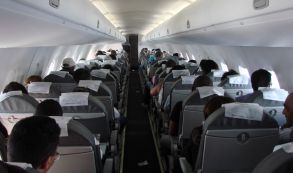The International Air Transport Association (IATA) announced global passenger traffic results for September showing solid demand growth compared to September 2014 for domestic and international traffic.
Total revenue passenger kilometers (RPKs) rose 7.3% compared to the year-ago period, slightly above the 7.1% growth achieved in August. September capacity (available seat kilometers or ASKs) increased by 6.6%, and load factor rose 0.5 percentage points to 80.7%.
"The demand for air travel in September was robust"”even with the economic slowdown in some key emerging markets such as China. The industry seems set for a positive end to 2015," said Tony Tyler, IATA"™s Director General and CEO.
| Sep 2015 vs. Sep 2014 | RPK Growth | ASK Growth | PLF |
| International | 7.0% | 6.9% | 80.5% |
| Domestic | 7.8% | 6.1% | 81.0% |
| Total Market | 7.3% | 6.6% | 80.7% |
| YTD 2015 vs. YTDÂ 2014 | RPK Growth | ASK Growth | PLF |
| International | 6.7% | 6.2% | 80.3% |
| Domestic | 6.6% | 5.7% | 81.5% |
| Total Market | 6.7% | 6.0% | 80.7% |
International Passenger Markets
September international passenger demand rose 7.0% compared to September 2014, with airlines in all regions recording growth. Total capacity climbed 6.9%, and load factor edged up 0.1 percentage points to 80.5%.
- European carriers saw demand increase by 7.1%, supported by economic recovery in the region. Capacity climbed 6.6% and load factor rose 0.4 percentage points to 85.1%, highest among the regions.
- Asia-Pacific airline"™ September traffic rose 6.8% compared to the year-ago period. Capacity increased 5.9% and load factor climbed 0.7 percentage points to 77.0%. The healthy performance occurred in spite of notable declines in trade activity in Emerging Asia as well as slower than expected growth in China.
- North American airline"™ traffic climbed 4.1%, which was matched by a capacity expansion of 4.1%. As a result, load factor was flat at 82.4%. Expectations for better economic performance are supporting travel demand.
- Middle East carriers had a 9.9% demand increase in September, well down on the 13.7% year-over year growth experienced in August, but still a very healthy result. Capacity rose 12.9% and load factor slipped 2.1 percentage points to 75.7%. Major economies in the region, including Saudi Arabia and the United Arab Emirates, have experienced slowdowns in non-oil sectors, however rates of growth remain robust.
- Latin American airlines saw September traffic climb 7.9% compared to September 2014. Capacity increased by 8.5%, however, causing load factor to dip 0.5 percentage points to 80.0%. Despite recessionary conditions in Brazil and Argentina, solid international trade activity has provided a boost to business-related travel.
- African airlines experienced their third consecutive month of positive traffic growth in September, posting a 5.2% rise compared to a year ago. However, the result could be owing to volatility in reported volumes, as fundamental economic drivers remain weak. Capacity rose 3.5%, and load factor improved 1.2 percentage points to 71.6%.
Domestic Passenger Markets
Domestic travel demand rose 7.8% in September compared to September 2014. All markets except Brazil showed growth with the strongest increases occurring in India, China and Russia. Domestic capacity climbed 6.1%, and load factor improved 1.3 percentage points to 81.0%.
| Sep 2015 vs Sep 2014 | RPK Growth | ASK Growth | PLF |
| Australia | 0.3% | 0.0% | 77.1% |
| Brazil | -1.3% | -1.8% | 79.1% |
| China P.R | 12.5% | 10.5% | 81.2% |
| India | 13.2% | 12.6% | 81.9% |
| Japan | 2.0% | -1.4% | 71.6% |
| Russian Federation | 12.1% | 13.0% | 77.8% |
| US | 6.9% | 4.6% | 84.2% |
| Domestic | 7.8% | 6.1% | 81.0% |
- Brazil"™s domestic demand slipped 1.3% in September compared to September 2014 as the economy slid further into recession with rising unemployment, and the Brazilian Real continued to decline against the dollar.
The Bottom Line : "Aviation"™s connectivity is vital to the health and well-being of the global economy. And financial strength is critical to the industry delivering its best. While the overall outlook is for a collective profit that covers the industry"™s cost of capital, parts of the industry are really struggling. The poor economic performance in Brazil is having a dramatic negative impact on the industry"™s performance in Latin America"™s largest market. There are a number of swift policy options that the government could take to stimulate the sector by reducing the burden of onerous taxes, punitive regulation and a crippling fuel pricing regime. A comprehensive policy response would unleash the power of aviation connectivity and pay big dividends across the economy. There is no time for complacency," said Tyler.



